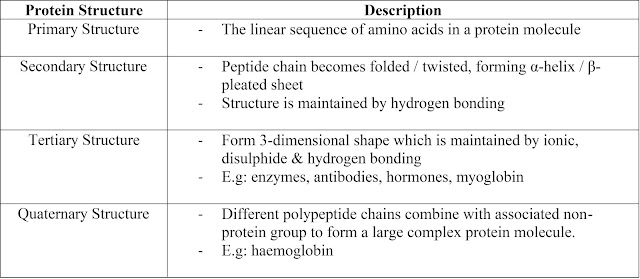 |
| Food that contain protein |
1. Consists of carbon, hydrogen, oxygen and nitrogen.
2. Sometime Sulphur and phosphorus may be present in some protein.
3. All proteins are made up of subunits called amino acids.
4. Each amino acid carries 2 functional groups:
- carboxyl group (-COOH)
- amino group (-NH2)
 |
| Amino acids basic structures |
5. Human need 20 types of amino acids to synthesize proteins.
6. 2 amino acids can combine to form a dipeptide by condensation reaction.
 |
| condensation reaction |
7. Long chains of amino acids are called polypeptides.
8. Proteins act as enzymes, hormones, antibodies, etc.
9. Changes in pH, temperature and salt concentration can cause proteins to lose their shapes and functions. This process is known as denaturation.
10. Importance:
- as building blocks of many structural components of the cell.
- form enzymes, hormones and antibodies.
Types of amino acids
The 20 amino acids needed by humans can be divided into 2 groups:
(a) Essential amino acids (11)
- cannot be synthesized by human body.
- for examples: leucine, lysine, histidine.
(b) Non-essential amino acids (9)
- can be synthesized by human body.
- for examples: alanine, glutamine, glycine.
Protein structures
There are 4 different structures of protein:


No comments:
Post a Comment